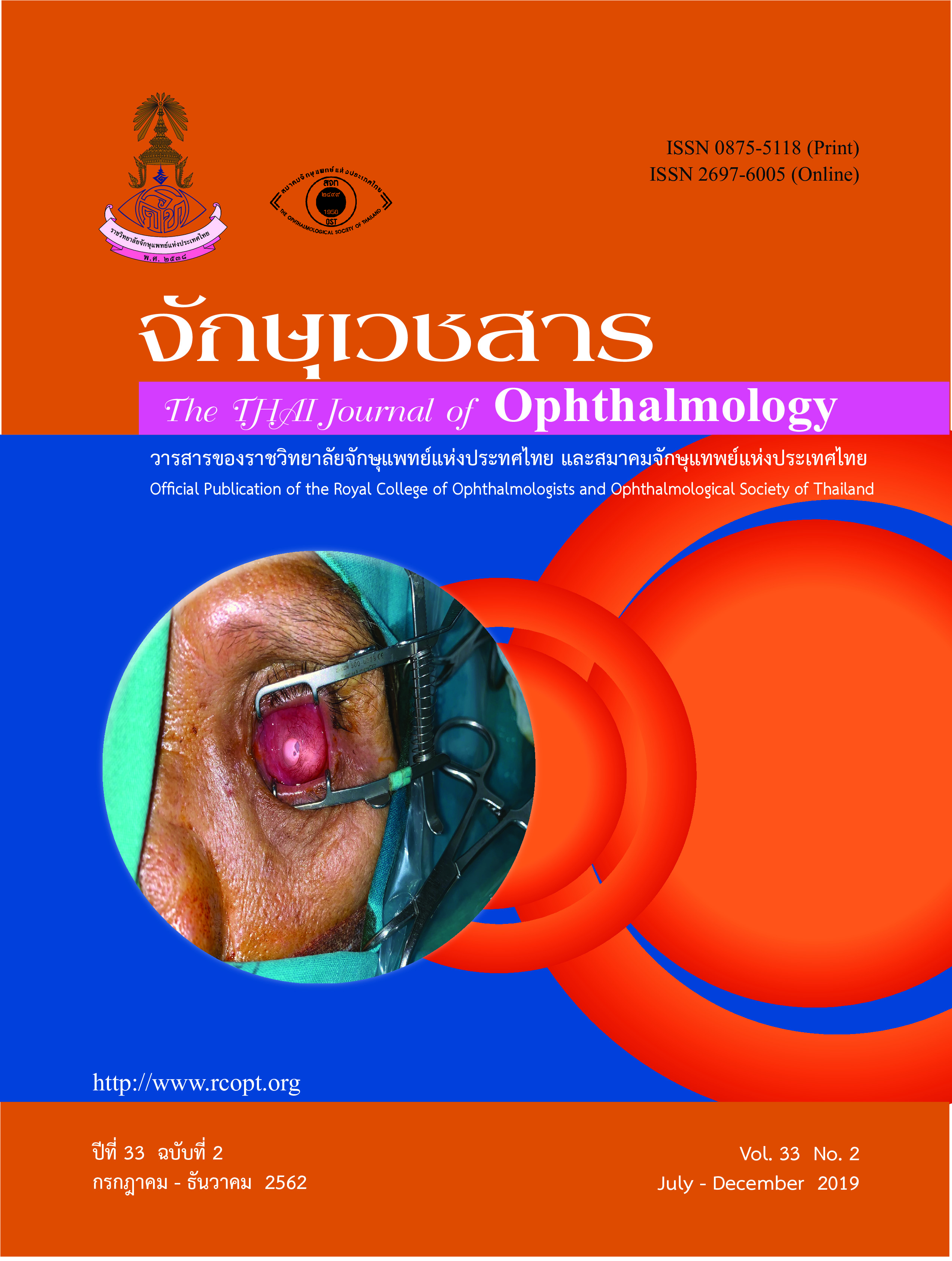Comparison of Pupil Dilation between Adrenaline 0.6 microgram/ml and 1.0 microgram/ml in Balance Salt Solution Intracamerally during Phacoemulsification
Abstract
Abstract
Objective: To study pupillary dilation in patients using intracameral Adrenaline 0.6 microgram/ml in balance
salt solution (BSS) (group A) and adrenaline 1.0 microgram/ml (group B) during phacoemulsification.
Study design: Prospective randomized clinical study.
Method: Study participants are patients underwent phacoemulsification in Trang Hospital by a single
surgeon. The patients’ age, sex, underlying diseases, cataract type, IOL power, pre- and post-operative
visual acuity were collected. The patients were randomized into group A (using adrenaline 0.6 microgram/
ml) And group B (using adrenaline 1.0 microgram/ml). Pupil diameters of each patient were measured
using caliper under operating microscope 3 times, first at the beginning of the surgery, second at one
minute after intracameral adrenaline in BSS irrigation, and third after viscoelastic injection. Standard
phacoemulsification was performed and the patients were managed routinely after the operation.
Results: There are 65 patients participated in the study. The average age was 67.8 ± 10.9 years. Fifty four
percent of the patients were male. The average pre-adrenaline injection pupil diameters were 5.6 ± 0.8
mm in group A and 6.0 ± 0.9 mm in group B. The average pupil diameters after adrenaline application
were 6.6 ± 1.0 mm in group A And 7.1 ± 0.8 mm in group B. The average pupil diameters after viscoelastic
injection were 7.3 ± 0.8 mm in group A and 7.7 ± 0.8 mm In group B. The mean visual acuity at one-week
post-operation were 20/40 in group A and 20/30 in group B. One person in group A had A post-operative
complication (increased intraocular pressure) which responded well after treatment.
Conclusion: Both concentration of adrenaline in BSS applied Intracamerally can increase pupillary dilation
and are useful in Phacoemulsification.
References
Grob SR, Gonjales-Gonjales LA, Daly MK. Management of mydriasis and pain in cataract and intraocular lens surgery: review of current medication and future
directions. Clin. Ophthalmol. 2014;8:1281-9.
Morgado G, Barr D, Martin J, Lima A, Martins N. comparative study of Mydriasis in cataract surgery: topical mydriasis versus intracameral mydriasis In
cataract surgery. Eur J Ophthalmol 2010;20:989-93.
Zaczek A, Zetterstrom C, cataract surgery and pupil size in patients with Diabetes mellitus. Acta Ophthalmol Scand. 1997;75:429-32.
Solomon KD, Turkalj JW, Whiteside Stewart JA, Apple DJ. Topical 0.5% Ketoralac versus 0.03% flurbiprofen for inhibition of miosis during cataract Surgery. Arch
Ophthalmol. 1997;115:1119-22.
Melanie C Cobett, Andrew B Richards. Intraocular adrenaline maintains Mydriasis during cataract surgery. Br J Ophthalmol. 1994;78:95-8.
Bjorn Lundberg, Anders Behndig. Intracameral mydriatics in phacoemulsification surgery obviate the need for epinephrine Irrigation. Acta Ophthalmol
Scand. 2007;85:546-51.
Thompson HS. In : Moses RA, Hart WM Jr, eds. Adler’s physiology Of the eye. St Louis: Mosby; 1989. p. 311-8.
Dohlman CH, Hyndiuk RA. Subclinical and manifest corneal oedema After cataract extraction. Symposium on the cornea. Transactions of the New Orleans Academy of ophthalmology. St Louis: Mosby; 1972. p. 221
Hull DS, Chemotti MT, Edelhauser HF, Van Horn DL, Hyndiuk RA. Effect Of epinephrine on the corneal endothelium. Am J Ophthalmol. 1975;79:245-50.
Edelhauser HF, Hyndiuk RA, Zub A, Schultz R. Corneal oedema and Intraocular use of epinephrine. Am J Ophthalmol. 1982;93:327-33.
Olson RJ, Kolodner H, Riddle P, Escapini H. Commonly used intraocular Medications and the corneal endothelium. Arch Ophthalmol. 1980;98:2224-6.
Adenis JP, Jabalot L, Leboutet MJ, Loubet R. Experimental study of the Toxicity of adrenaline on the corneal endothelium. Application to
extracapsular Cataract surgery. Bull Mem Soc Fr Ophthalmol. 1985;96:428-31.
Freeman JM, Gettelfinger TC. Maintaining pupillary dilatation during lens Implant surgery. Am Intraocular Implant Soc J 1981;7:172-3.
Oomijiya T, Matsumura S, Aragaki H, Miyara N, Hayakawa K, Yamakawa R, Nagataki S. Antimiotic effect of epinephrine in the irrigating solution during
Cataract surgery. Clin Ophthalmol. 1994;48:1837-40.
Behndig A, Korobelnik JF. Mydriatic insert and intracameral injection compared with mydriatic eye drops in cataract surgery: controlled studies. J
Cataract Refract Surg. 2015;41:1503-19.
Myers WG, Shugar JK. Optimizing the intracameral dilation regimen for Cataract surgery: Prospective randomized comparison of 2 solutions. J Cataract
Refract Surg. 2009;35:273-6.
Vidal olliver E, Schwadrohn G, Moilord C, Balan Sard G, Ollivier B. Assay For epinephrine and its impurities using reversed-phase high performance
liquid chromatography. J Chromatogr. 1987;396:421-4.
Buratto L, Giardini P, Bellucci R. Viscoelastics in ophthalmic Surgery. Thorofare, NJ: Slack, Inc; 2005. p. 5.
Lane SS, Lindstrome RL. Viscoelastic agents: formulation, clinical applications, and complications. In:Steiwert RF, ed. Cataract surgery : Technique, Complication, and management. Philadelphia: Saunders; 1995. p. 37-45.
Oshika T, Eguchi S, Oki K, et al. Clinical comparison of healon 5 and healon In phacoemulsification and intraocular lens implantation: randomized
multicenter study. J Cataract Refract Surg 2004; 30(2):357-62.
Downloads
Published
Issue
Section
License
The Thai Journal of Ophthalmology (TJO) is a peer-reviewed, scientific journal published biannually for the Royal College of Ophthalmologists of Thailand. The objectives of the journal is to provide up to date scientific knowledge in the field of ophthalmology, provide ophthalmologists with continuing education, promote cooperation, and sharing of opinion among readers.
The copyright of the published article belongs to the Thai Journal of Ophthalmology. However the content, ideas and the opinions in the article are from the author(s). The editorial board does not have to agree with the authors’ ideas and opinions.
The authors or readers may contact the editorial board via email at admin@rcopt.org.


